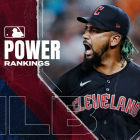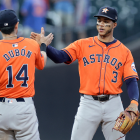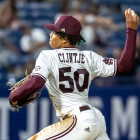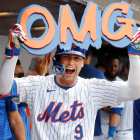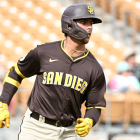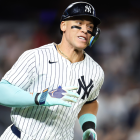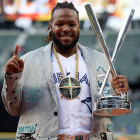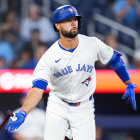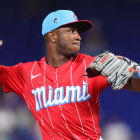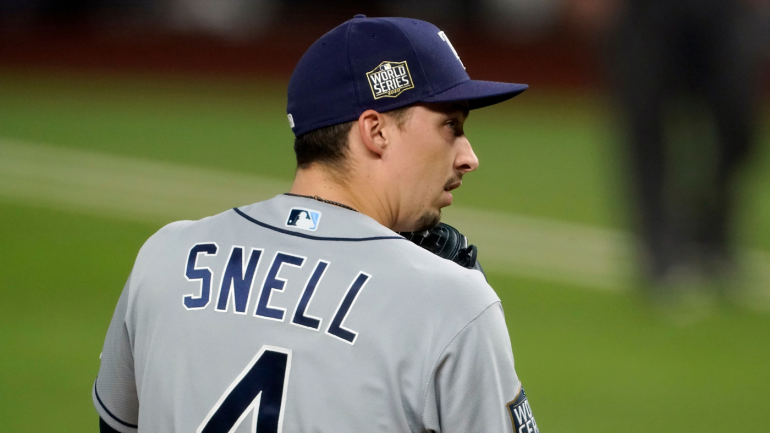
On Sunday night, the San Diego Padres and Tampa Bay Rays agreed to a five-player trade that will send left-handed pitcher Blake Snell to the west coast in exchange for four youngsters: right-handers Luis Patino and Cole Wilcox and catchers Francisco Mejia and Blake Hunt.
Snell's departure comes two months after he was prematurely removed from Game 6 of the World Series. The Rays bullpen would blow their lead, costing them the game and their chances at forcing a decisive Game 7. Snell, the 2018 American League Cy Young Award winner, completes his Rays career having appeared in 108 games while compiling a 130 ERA+ and a 2.79 strikeout-to-walk ratio.
Finances always play a role in Tampa Bay's trades, and this one is no exception. Snell, 28, is scheduled to make $11 million in 2021, meaning he would've accounted for nearly 20 percent of the Rays' projected Opening Day payroll, per Cot's Contracts. With Snell elsewhere, the Rays are now forecasted to have an Opening Day payroll around $52 million, depending on who they add and who they subtract (Kevin Kiermaier? Yoshi Tsutsugo?) the rest of the way.
Snell is under contract through the 2023 season, meaning the Padres have obtained both a potential long-term fit and a short-term replacement for Mike Clevinger, who underwent Tommy John surgery earlier this offseason.
We here at CBS Sports are nothing if not judgmental. As such, we've decided to break down the trade while providing grades for each team. Let's proceed to that part of the endeavor now, beginning with a recap of the moving pieces:
- Padres receive: LHP Blake Snell
- Rays receive: RHP Luis Patino, RHP Cole Wilcox, C Francisco Mejia, C Blake Hunt
Padres grade: A
In Snell, the Padres are acquiring a dilemma: how much of his success can be credited to Tampa Bay's restrictive usage? Snell has averaged fewer than five innings per start across the last two seasons, a stat that isn't attributable only to his efficiency woes or the understandable circumstances in 2020 that saw almost every starter do less work. During that span, he's recorded nearly twice as many starts in which he's thrown fewer than 80 pitches (13) as starts in which he's thrown more than 100 pitches (eight).
While it's heretical in some circles to question the Rays, for they See a Different Game, the Padres have to be wondering if they can extract additional value from Snell by allowing him to operate like a normal starting pitcher -- the way they permitted Zach Davies and Dinelson Lamet, each of whom averaged an additional frame (5.8) per start more than the Padres' staff did as a whole (4.8). There's risk in the unknown, of course, and it's not only a matter of the trade-off between Snell's bottom-line production and his innings count (though that is important); it's also about his health.
Including this year, Snell has taken a full slate of starts twice in four complete seasons. He missed time in 2018 because of shoulder fatigue, and then time again in 2019 because of a fractured toe and loose bodies in his elbow. It bears wondering if asking Snell to do more on a per-game basis would result in less of him overall.
Anyway, let's not permit the conceptual to obscure the actual. Snell has proven himself to be an above-average starter (albeit at times a maddeningly inefficient one) who has a penchant for strikeouts. He does that by leveraging a four-pitch arsenal: a mid-90s fastball with good spin that he throws more than half the time; an upper-80s changeup; a slider that batters went 1 for 30 against in 2020; and a curveball that has coerced whiffs on more than half the swings taken against it the past four years. (That repertoire should theoretically allow him to work deeper into games, but hey, it's complicated.)
There's a lot to like about Snell as a pitcher, and there's a lot to like about him as a piece of a roster. His contract is more affordable than what his free-agent equivalent would have received (Zack Wheeler will make twice as much in 2021), and that financial flexibility should prove beneficial. The Padres, to their credit, are known to be pursuing Korean infielder Ha-Seong Kim. Rival teams also believe the Padres still have interest in right-hander Yu Darvish, whom they talked about last week with the Chicago Cubs.
As for the prospect portion of the deal, a source once told CBS Sports that A.J. Preller is very good at trading away players he doesn't like. San Diego has been an active buyer over the past six months without sacrificing the top of the system, and it still has the depth to deal more if the opportunity presents itself. Snell is the first big addition for the Padres this winter, but that doesn't mean that he's going to be the last -- especially if Preller is serious about building a monster to chase down the Los Angeles Dodgers.
Rays grade: B
We're going to do our best to avoid the same talking points that surface whenever the Rays trade an established star for a package of younger (read: cheaper) players. By now, it should be clear what owner Stuart Sternberg prioritizes from his baseball team -- and it ain't championships or the adoration of the fan base. Anyone willing to justify it will; everyone else can roll their eyes at the near-billionaire and his nihilism.
Contrary to popular belief, the Rays do lose trades -- frequently, even, when their front office is being hectored to reduced payroll. This isn't a Sternberg Special by any means, but there is more risk here than the players' collective name-brand appeal suggests.
Patino is the closest thing the Rays' return has to a "centerpiece." He spent most of the season in the majors, working an ineffectual 11 appearances. Patino is a quality athlete who averaged 97 mph on his heater and who generated nearly 50 percent whiffs with his slider during his big-league outings. He's on the smaller side, however, and he needs to continue to develop his changeup and his command if he wants to remain in a starting role long-term. The Rays have a history of suppressing their best players' service time; in Patino's case, it seems reasonable to think he could stand for more seasoning: coming into 2020, he'd appeared in just two games above the A-ball level.
Mejia is the closest thing the Rays' return has to a "veteran." He's accrued more than two years of service to date, putting him a season away from reaching arbitration. There have long been concerns that Mejia is too small to handle a full workload behind the dish (he's listed at 5-foot-8, 188 pounds); it doesn't help his case that he graded as a below-average framer prior to an uptick in 2020 that could be a small-sample mirage. The Rays could have him try his hand at another position -- perhaps DH if they find a taker for Yoshi Tsutsugo -- as a means of freeing up his bat. The downside is that Mejia hasn't hit much as a big-league player: his career line is .225/.282/.386 (78 OPS+) through his first 362 plate appearances. He has been better against righties, at least.
Wilcox, San Diego's third-round pick this year, hasn't yet made his professional debut. The Padres pried him away from returning to the University of Georgia by handing him a signing bonus exceeding $3 million. Wilcox has a starter's frame and a good slider, but some evaluators feel he's likely to end up in the bullpen -- where, to be fair, he could sink and slide his way into a high-leverage role.
Then there's Hunt, the Padres' second-round pick in 2017, who is the inverse of Mejia in the sense that he's larger than the standard backstop (6-foot-3, 215 pounds). Hunt had been a better-than-average hitter in each of the past two seasons, and that was before he altered his swing this year. Depending on if that change will allow him to tap into more raw power once the minors resume, he could be one worth watching.










